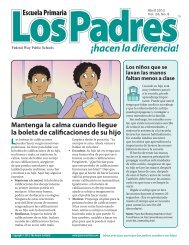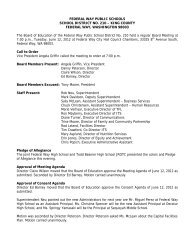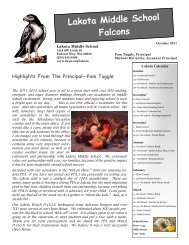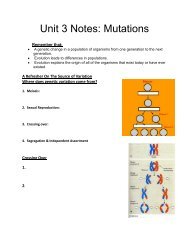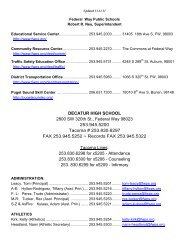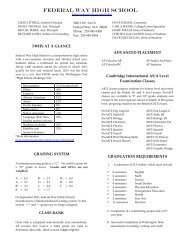Macromolecules: An Introduction to Cell Products - School Web Sites
Macromolecules: An Introduction to Cell Products - School Web Sites
Macromolecules: An Introduction to Cell Products - School Web Sites
You also want an ePaper? Increase the reach of your titles
YUMPU automatically turns print PDFs into web optimized ePapers that Google loves.
<strong>Macromolecules</strong>: <strong>An</strong><br />
<strong>Introduction</strong> <strong>to</strong> <strong>Cell</strong> <strong>Products</strong><br />
9-11 PS 2F: All forms of life are composed of large<br />
Molecules that contain carbon. Carbon a<strong>to</strong>ms bond<br />
To each other and other elements by sharing electrons,<br />
Forming covalent bonds. Stable molecules of carbon<br />
Have four covalent bonds per carbon a<strong>to</strong>m.
Nutrients: The Matter of Life<br />
In order for organisms <strong>to</strong> grow, function and<br />
reproduce, certain raw materials are<br />
required.<br />
These raw materials provide:<br />
1. Energy: For movement, work, cellular<br />
processes, growth and reproduction.<br />
2. Building materials: To make the raw<br />
materials <strong>to</strong> make cells and tissues (skin,<br />
muscle).
ORGANIC COMPOUNDS<br />
• These raw materials have many names and<br />
titles, but because they are manufactured by<br />
living cells these macromolecules are<br />
referred <strong>to</strong> as ORGANIC COMPOUNDS<br />
All of these compounds come from our diet,<br />
the foods we eat and are broken down by our<br />
digestive system, and then reassembled in<strong>to</strong><br />
the building blocks <strong>to</strong> make our cells and<br />
tissues.
ORGANIC COMPOUNDS<br />
• There are three categories of organic compounds:<br />
1. Carbohydrates: Primarily used as the fuel <strong>to</strong><br />
make our cells and bodies function. “Glucose” is<br />
the molecule that serves as the primary cellular<br />
fuel.<br />
2. Proteins: Primarily used as the building materials<br />
for our cells and tissues.<br />
a. Enzymes: Used <strong>to</strong> speed up the chemical<br />
reactions in our cells.<br />
3. Lipids: Primarily used as a building material for<br />
our cells and tissues.
How are organic compounds<br />
manufactured by our cells?<br />
• Our cells are actually complex working<br />
machines. Inside these “machines” are<br />
small structures called ORGANELLES, that<br />
have specific functions and responsibilities.<br />
• The organelles take the raw materials <strong>to</strong><br />
break down and reassemble them in<strong>to</strong><br />
specific products that end up being<br />
carbohydrates, proteins, lipids or enzymes.
Take It From the Top<br />
• This is where the<br />
creation of the<br />
organic compounds<br />
begins.<br />
The foods you eat are the source of the raw materials that<br />
will eventually become the carbohydrates <strong>to</strong> fuel your<br />
activities, proteins <strong>to</strong> make muscle and skin, enzymes<br />
<strong>to</strong> make your metabolism function and lipids <strong>to</strong> create cells.
Digestion<br />
Digestion is the process where our bodies take<br />
large, complex molecular mixtures and break<br />
them down in<strong>to</strong> their individual organic<br />
building blocks.<br />
There are two types of digestion:<br />
1. Mechanical Digestion: Your teeth grinding<br />
and crushing food, as well as the s<strong>to</strong>mach<br />
squeezing the food you have swallowed.<br />
2. Chemical Digestion: Enzymes and digestive<br />
juices in your saliva and digestive tract that<br />
break apart the chemical bonds that hold the<br />
molecules <strong>to</strong>gether.
The Digestive System<br />
The digestive system is<br />
a series of glands and<br />
organs that are<br />
responsible for<br />
taking the food you<br />
eat and breaking it<br />
down in<strong>to</strong> it’s<br />
individual molecular<br />
components.
Organs of the Digestive System<br />
1. Mouth: site where both<br />
mechanical (chewing)<br />
and chemical<br />
(saliva)digestion begin.<br />
2. Salivary Glands: Produce<br />
saliva for chemical<br />
digestion (starch/carbs).<br />
3. Esophagus: Muscular<br />
tube that squeezes food<br />
in<strong>to</strong> the s<strong>to</strong>mach.<br />
3b. S<strong>to</strong>mach: Site of<br />
mechanical and chemical<br />
digestion (s<strong>to</strong>mach acids<br />
and enzymes).
Organs of the Digestive System<br />
4. Small Intestine:<br />
Digestion finishes here,<br />
then the newly broken<br />
down nutrient molecules<br />
are absorbed in<strong>to</strong> the<br />
bloodstream <strong>to</strong> be carried<br />
<strong>to</strong> the cells.<br />
5. Large Intestine: Site<br />
where water is absorbed<br />
from the remains of the<br />
digested waste.
Organs of the Digestive System<br />
6. Liver: Produces bile <strong>to</strong><br />
break down fats (lipids)<br />
and converts extra<br />
glucose in<strong>to</strong> glycogen.<br />
7. Gall Bladder: S<strong>to</strong>res<br />
extra bile.<br />
8. Pancreas: Regulates<br />
the level of glucose in<br />
the bloodstream.<br />
9. Rectum: Site where all<br />
the lef<strong>to</strong>ver waste (feces)<br />
is s<strong>to</strong>red until you are<br />
ready <strong>to</strong> get rid of it.
Overview<br />
A. Step 1: Food is eaten, then broken down by<br />
digestive system in<strong>to</strong> the individual building<br />
blocks of carbs, proteins and lipids that made<br />
up the food.<br />
B. Step 2: The nutrients are absorbed in<strong>to</strong> the<br />
bloodstream and transported <strong>to</strong> the cells.<br />
C. Step 3: The cells take these building blocks<br />
and reassemble them in<strong>to</strong> new combinations<br />
<strong>to</strong> create the carbs, proteins and lipids our<br />
bodies need.
Carbohydrates<br />
1. Used primarily as the first source of cellular<br />
energy (glucose).<br />
2. The primary building block of carbs is a<br />
“saccharide” (a single sugar molecule/unit).<br />
3. There are two types of carbohydrates:<br />
a. Simple carbohydrates: made of a single sugar<br />
molecule.<br />
b. Complex carbohydrates: made of more than<br />
one sugar unit.<br />
4. Carbohydrates are also used as a structural<br />
building material in plants (cellulose in plants –<br />
used <strong>to</strong> make paper and clothes).<br />
5. Most carbohydrates are produced by plants<br />
through the process of pho<strong>to</strong>synthesis.
Classes of Carbohydrates<br />
There are three classes of carbohydrates. The<br />
number of sugar units (saccharides) in the<br />
molecule determines which class the<br />
carbohydrate belongs <strong>to</strong>.<br />
1. Monosaccharides: Made up of only one<br />
sugar unit.<br />
2. Disaccharides: Made up of two sugar<br />
molecules bonded <strong>to</strong>gether.<br />
3. Polysaccharides: Made up of at least 3 sugar<br />
molecules bonded <strong>to</strong>gether.
Monosaccharides<br />
• These are the simple sugars. They are composed<br />
of a single sugar unit called a saccharide.<br />
1. These molecules are ready <strong>to</strong> provide energy for<br />
the cell.<br />
2. Examples: Glucose, Fruc<strong>to</strong>se (fruit sugars) and<br />
galac<strong>to</strong>se (a type of dairy sugar).<br />
3. Dietary Sources: Fruits, honey, juices, corn<br />
syrup and vegetables.
Disaccharides<br />
• These are a type of complex carbohydrate.<br />
They are composed of two monosaccharides<br />
chemically bonded <strong>to</strong>gether.<br />
1. In order <strong>to</strong> be used <strong>to</strong> produce energy, they<br />
need <strong>to</strong> be split apart in<strong>to</strong> the two sugars.<br />
2. Examples: Sucrose (table sugar), lac<strong>to</strong>se<br />
(milk sugar) and mal<strong>to</strong>se (grain sugar).<br />
3. Dietary sources: Sweets/candy, milk,<br />
dairy products and syrup.
Polysaccharides<br />
• Complex carbohydrate composed of at least<br />
three mono’s bonded <strong>to</strong>gether. Typically LONG<br />
chains.<br />
1. This is a s<strong>to</strong>rage form of energy for cells and<br />
tissue.<br />
2. Must also be broken in<strong>to</strong> individual sugar units<br />
<strong>to</strong> be able <strong>to</strong> serve as a source of cellular energy.<br />
3. These tend <strong>to</strong> come from the “s<strong>to</strong>rage” parts of<br />
plants: roots and seeds.
Polysaccharides<br />
4. Dietary Sources: Rice, grains, starches, pota<strong>to</strong>es.<br />
5. Examples<br />
a. Starch: primary s<strong>to</strong>rage form of energy in<br />
plants. Usually found in seeds and roots.<br />
b. <strong>Cell</strong>ulose: primary component in the cell wall<br />
of plant cells. Wood pulp (for paper and<br />
cardboard) and cot<strong>to</strong>n are examples of cellulose.<br />
c. Glycogen: This is the s<strong>to</strong>rage form of energy in<br />
animals (our version of starch).<br />
i: When our cells have absorbed all the glucose<br />
they can, the extra is converted in<strong>to</strong> glycogen and<br />
s<strong>to</strong>red in the liver and muscle tissue.<br />
ii: Glycogen is used as an “emergency reserve”.
Carbohydrate Deficiency<br />
• What happens if your body is not able <strong>to</strong> get<br />
the carbohydrates it needs?<br />
A. Your cells will not be able <strong>to</strong> provide the<br />
energy you need for work/activity.<br />
B. You will become tired due <strong>to</strong> a lack of energy.<br />
C. The body will begin <strong>to</strong> break down fat, then<br />
protein in order <strong>to</strong> get the energy it needs.<br />
1. Eventually, if it doesn’t change, the fat and muscle<br />
will be consumed by the body (anorexia).
Carbohydrate Summary<br />
• ALL carbohydrates are manufactured by<br />
plants through the process of pho<strong>to</strong>synthesis.<br />
• The only exception are lac<strong>to</strong>se (milk sugar)<br />
and glycogen.<br />
– These take the monosaccharides from foods that<br />
were consumed and released through digestion,<br />
then rearranged by the cells in<strong>to</strong> their final<br />
product (lac<strong>to</strong>se, galac<strong>to</strong>se or glycogen).
Proteins<br />
Protein is an important component of every cell<br />
in the body. If you remove the water from our<br />
bodies, we are 75% protein.<br />
A. Your body uses protein <strong>to</strong> build and repair<br />
cells & tissues.<br />
B. Proteins are also used <strong>to</strong> make enzymes and<br />
hormones <strong>to</strong> regulate the chemical reactions<br />
in your cells.<br />
C. Proteins are an important building block in<br />
bones, muscle, skin and blood.<br />
D. Proteins can also be used as a source of energy<br />
if there are no carbohydrates or fats available.
Proteins<br />
• When foods containing protein are<br />
digested in your body, the protein is<br />
broken down in<strong>to</strong> the individual units that<br />
make up the protein.<br />
• These “units” or building blocks are called<br />
amino acids.<br />
• Amino acids are linked <strong>to</strong>gether in<br />
different lengths or chains depending on<br />
what needs <strong>to</strong> be manufactured. Each<br />
protein has a different length and<br />
sequence.
Proteins<br />
Amino acids are the building blocks of<br />
proteins.<br />
1. A protein is formed when aa’s are linked<br />
<strong>to</strong>gether in<strong>to</strong> chains of varying lengths and<br />
sequences.<br />
2. There are 20 amino acids, our<br />
body produces 12<br />
of them. The other 8<br />
we<br />
get from the foods.<br />
we eat.
Proteins<br />
• Dietary sources of proteins are:<br />
a. beef<br />
b. poultry<br />
c. fish<br />
d. eggs & dairy products<br />
e. nuts & seeds<br />
f. legumes (lentils and black beans)
Enzymes<br />
1. Enzymes are a special form of a protein.<br />
2. They are classified as being “catalysts”.<br />
3. Catalysts are substances that speed up the rate of<br />
chemical reactions, and are not changed by that<br />
reaction.<br />
4. Without enzymes, the chemical reactions in most<br />
organisms would not occur fast enough <strong>to</strong> sustain<br />
life. Our metabolism won’t work without them.<br />
5. Enzymes are temperature dependent:<br />
work slower in colder<br />
temperatures,<br />
faster in warmer<br />
temperatures.
Protein Deficiencies<br />
• What if your body does not get the amount of<br />
protein it needs?<br />
A. This is a risk in vegetarian based diets.<br />
Eating non-animal sources of protein will<br />
take care of any problems.<br />
B. Without enough protein, the body will:<br />
1. Not grow and develop as it should.<br />
2. You will become weaker due <strong>to</strong> muscle wasting.<br />
3. Your immune system will become weak.
Lipids<br />
• You know lipids as “fats”. However, in the<br />
scientific world, they are also called<br />
“triglycerides”.<br />
• Lipids are a molecule made up of a glycerol<br />
group and fatty acids.<br />
A. Lipids are used primarily as a structural<br />
component in the cell membrane.<br />
B. Lipids are also used <strong>to</strong> insulate nerve cell<br />
fibers.<br />
C. Lipids are also used as a source of energy<br />
if there are no available carbohydrates.
Two Classes of Lipids<br />
1. Saturated Fats<br />
a. These are the “bad fats”, as their molecular<br />
structure makes it difficult for the body <strong>to</strong><br />
break down and they tend <strong>to</strong> build up in the<br />
blood vessels.<br />
b. Dietary sources: whole milk products (ice<br />
cream, butter, whole milk), lard, red meats,<br />
coconut oil. Mostly “animal sources”.
Two Classes of Lipids<br />
2. Unsaturated Fats<br />
a. These are the “good fats”.<br />
b. Their molecular structure allows them <strong>to</strong><br />
dissolve more easily in our body.<br />
c. These are liquid at room temp, whereas the<br />
saturated fats are solid at room temps.<br />
d. Dietary sources: cooking oils (safflower,<br />
canola, olive & corn), avocados, nuts and<br />
fish.
What About Trans-fats?<br />
Trans-fats are chemically altered “unsaturated<br />
fats” that are turned in<strong>to</strong> “saturated fats”.<br />
A. This is done <strong>to</strong> make the fat more stable at<br />
room temperature.<br />
B. These tend <strong>to</strong> be unhealthy, like saturated<br />
fats.<br />
C. They have been linked <strong>to</strong> cancer.<br />
D. Examples: anything that contains<br />
“hydrogenated” or “partially hydrogenated”<br />
fats.
Lipid Deficiencies<br />
• What happens if we do not get enough lipids<br />
in our diet?<br />
1. Nutritionists estimate that 20% of our daily<br />
calories should be from healthy sources of<br />
lipids.<br />
2. Your skin, hair & nails become dry/brittle.<br />
3. Stiff joints.<br />
4. Excessive menstrual/pre-menstrual cramps.
Lipids: The Summary<br />
• Fats/lipids have a great deal of energy<br />
s<strong>to</strong>red in their bonds. This is why the<br />
human body converts excess glucose <strong>to</strong> fat<br />
<strong>to</strong> s<strong>to</strong>re it.<br />
• When your body needs the extra fuel, it<br />
breaks down the fat and uses that energy.<br />
• Fats contain more than twice the energy of<br />
a molecule of glucose.<br />
– One pound of fat produces 4320 Kcal of<br />
energy, enough <strong>to</strong> raise the temperature of<br />
more than 10 gallons of water from the<br />
freezing point <strong>to</strong> the boiling point.
The Wrap-Up<br />
1. Our bodies require the three nutrient<br />
groups for energy and building materials.<br />
2. The function of the digestive system is <strong>to</strong><br />
take the complex foods we eat and break<br />
them down in<strong>to</strong> their smallest unit.<br />
3. Those are then absorbed in<strong>to</strong> the<br />
bloodstream, carried <strong>to</strong> cells and put <strong>to</strong> use<br />
(see #1).<br />
4. Carbohydrates are the primary cellular<br />
fuel. There are three different types.
5. Polysaccharides provide the greatest amount of<br />
energy. They are a complex carb.<br />
6. Proteins are used primarily as a building<br />
material in our cells & tissues.<br />
7. When proteins are digested, they are broken<br />
down in<strong>to</strong> amino acids.<br />
8. Amino acids are reorganized in<strong>to</strong> thousands of<br />
different protein combinations.<br />
9. <strong>An</strong> enzyme is a special type of protein that is<br />
required for our metabolism <strong>to</strong> occur.
10. Lipids are also used as a structural<br />
component (like proteins). They also<br />
insulate our nervous system.



